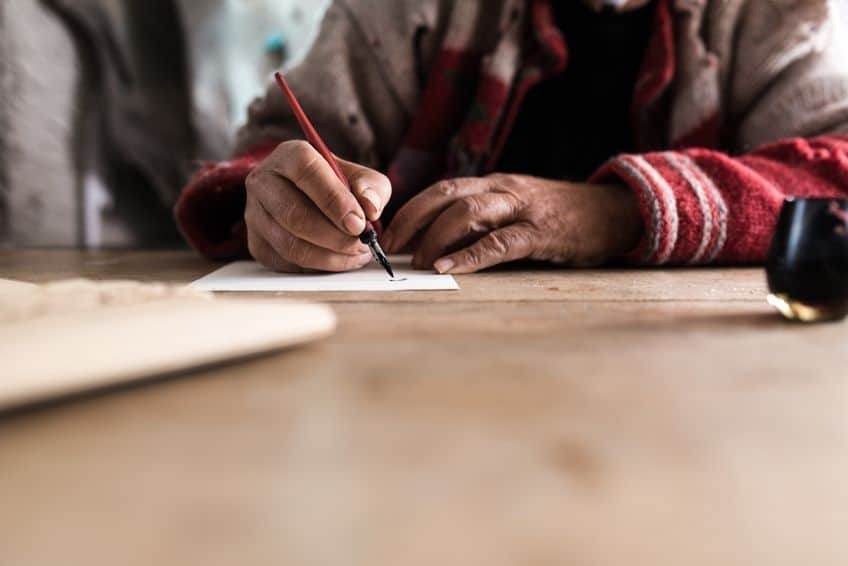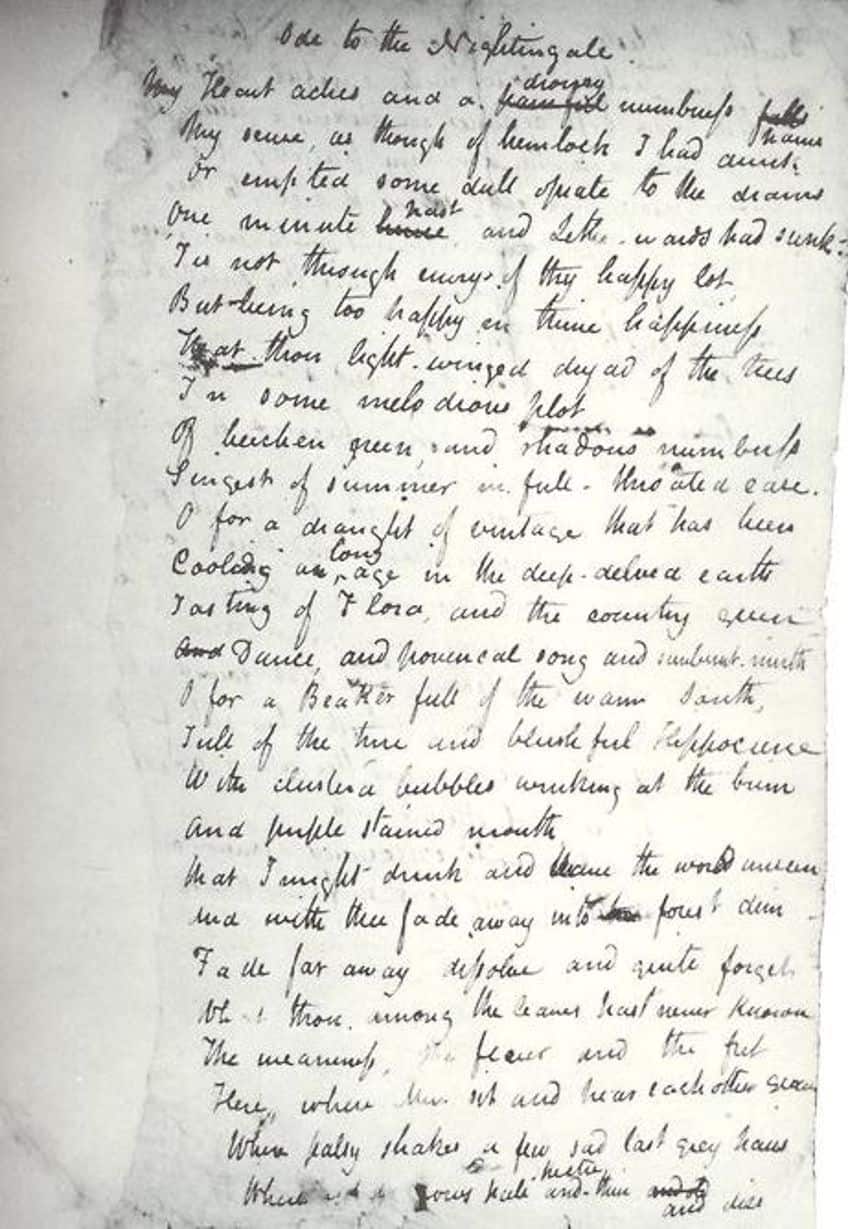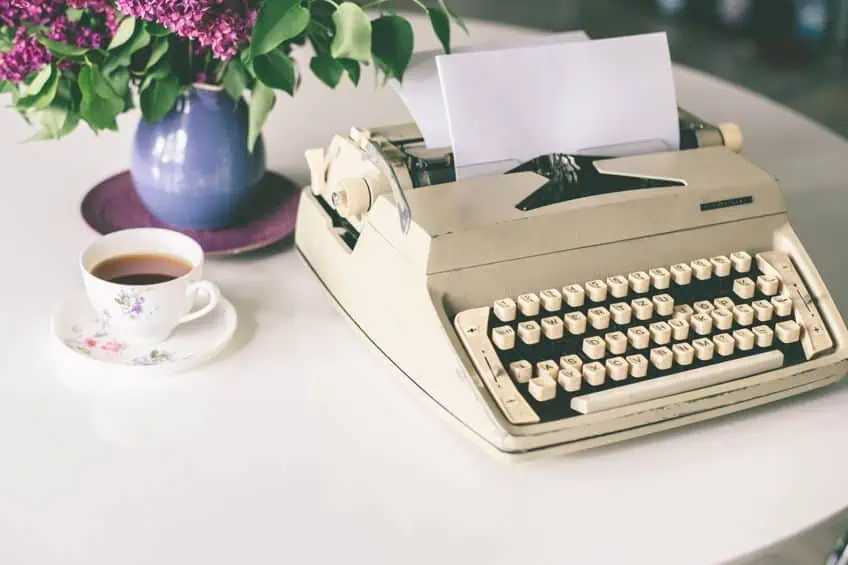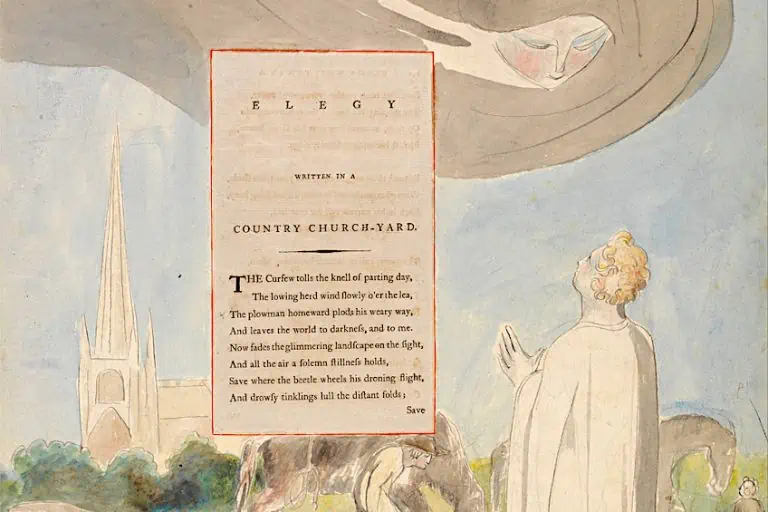How to Write a Poem – A Guide to Writing Poetry for Beginners
This post may contain affiliate links. We may earn a small commission from purchases made through them, at no additional cost to you.
Poetry is an ancient form of literary art that has been used in a myriad of places around the world and in different forms. This article will go into some detail about poetry so that you can familiarize yourself with the medium and, if you want, you may even learn about how to write a poem. We will discuss the different types of poems, some terms you should know, some aspects of poetry itself, and even some academic examinations of the medium. So, let’s have a look at poetry and get familiar with it.
Table of Contents
How to Write a Poem
There are many people out there who wonder about how to write poetry, but poetry, like many literary mediums, is one that is best learned through practice and experimentation. You will only truly learn how to write a poem if you start writing poems. However, that being said, it can be helpful to have a few poem-writing tips and explanations of poetic ideas.
The better you understand and are familiar with poetry, the better you may be at writing poetry.
Before we get started and start to properly have a look at many of these ideas, it should be noted that, much like other mediums, one of the most important things that you can do to become more familiar with poetry is to actually read some. You get better at writing prose by reading books and you get better at making movies by watching movies. You learn from seeing what others have done.

Another very important thing to keep in mind is that when you get started with anything in this world, and writing poetry is no exception, you probably won’t be all that good at first. There’s nothing wrong with this. Leonardo da Vinci didn’t start out by painting the Mona Lisa, he started out when someone put a brush in his hand and showed him how to apply it to a canvas. So, while this may be focused on writing poetry for beginners, it is always worth remembering and reminding yourself that you have to start somewhere.
In fact, you should be pleased if the first things that you write are not all that great. The reason that you should be glad is because when you get started, you are experimenting. You should experiment throughout your artistic endeavors, but when you get started, you will inherently be experimenting. And something about experimentation that many seem to forget is that experiments can often fail.
However, when an experiment fails, it’s up to you to learn from that failure.
If you attempted to write a specific type of poem and discovered that you are not good at a particular aspect of poetry, then you should focus on that particular aspect. If you discover that your vocabulary is lower than you want it to be, start doing a word-a-day calendar. If you discover that you struggle with rhyme, make use of a rhyme dictionary to get you on your feet. If you discover that you can’t stick to a particular form, try a new form. No matter what you try, you will be improving, and that should be what you strive for.
Some poem-writing tips may help you with writing poetry, but you can only truly learn by doing it yourself, seeing where your strengths and weaknesses lie, and then focusing on them. Now, before we look at some more specific aspects of where you may wish to apply your focus when it comes to how to write a poem, let’s first have a look at what a poem is in the first place.
What Is a Poem?
A question like this probably seems rather obvious. We all know what a poem is, right? However, defining a poem is like defining certain parts of speech. If someone asked you to give a definition of a word like “stove”, you could easily respond that it is a kitchen appliance used for cooking. However, if you were asked to define the word “the”, you may have more trouble. It is a definite article, but how do you explain what it actually is? This is a similar issue with a poem.
Many would claim that a poem is a short text that features rhyme. The only problem there is that you can get poems like Paradise Lost, which is hundreds of pages long.
As for rhyme, not all poems rhyme. There are poems that have no structure whatsoever. A poem can be as long or as short as you want it to be, it can or cannot have rhyme, it can make use of interesting typography or it may be laid out like plain text, it could make use of unusual language choices or it could be presented in a straightforward manner, and so on.

This is why poetry is often defined by what it isn’t. Poetry is a literary genre that is not prose, drama, or prosaic. This means that it is not a novel (although some poems do tell stories), it is not a play (although some plays make use of poetic language), and it is not prosaic (although non-creative writing can still make use of poetic techniques).
This makes defining a poem something rather irritating. This is also why if you were to Google the definition, it would claim that a poem expresses feelings and ideas (which is an incredibly broad thing to say, and one could claim this about any other piece of writing) and that it pays particular attention to diction, imagery, and rhythm. Not all poems make particular use of imaginative diction though, and imagery is generally integral to all forms of writing to a certain degree. Rhythm is also something that does not have to be in a poem.
So, what does all this irritating back and forth mean for someone who wants to learn how to write poetry? Well, it means that there really aren’t any rules that you should be overly worried about. A poem is whatever you want it to be. If you want to stick to rigid poetic forms, then you can do that, and we will discuss a few different types of poems below to help with understanding them. However, if you also just want to write in a free verse style and make it up as you go, there’s nothing stopping you.
But let’s have a look at those different types of poems in case you want to try out a specific one.
The Different Types of Poems
Let’s have a look at a few different varieties here. There are many different types of poems out in the wide world, and many of them are quite specific to certain cultures. Some have rigid rules and others do not. We are only going to have a look at a few examples today, but there are many others out there. So, let’s have a look at six of them:
- Sonnet: Likely the most famous form in the English language. This form makes use of a fourteen-line structure that includes a specific rhyme scheme. The most common of them are usually either Elizabethan/Shakespearean sonnets (ABAB CDCD EFEF GG) or Italian/Petrarchan sonnets (ABBAABBA CDE CDE). You can, of course, use your own rhyme scheme though.
- Ballad: These poetic forms are very versatile and, as such, have been used in a lot of contemporary music. They do not necessarily have a set number of lines, but they are usually structured around quatrains (four-line stanzas) and they make use of an ABAB or ABCB rhyme scheme. They also usually tell stories.
- Acrostic: This is a rather sweet poetic form that entails a specific form in which the first letter of each line is used to spell something out. This means that the poem can be read both horizontally and vertically (or at least one line can be read vertically). It isn’t often considered a “serious” poetic form, but you get to decide what you want to try.
- Limerick: This type of poetry is often used for humorous reasons. It makes use of a five-line structure with an AABBA rhyme scheme. These simple poems have often been used to tell jokes where the first four lines establish a setup, and the final line ends it on a funny quip of some kind.
- Haiku: This is a Japanese form of poetry that makes use of a specific syllable structure. They use three lines, but the syllable count on those lines is what’s important. The first has five, the second has seven, and the third has five. They don’t have to rhyme and are usually about presenting a simple thought or feeling.
- Free verse: There are no rules to free verse because you can do whatever you like. It can have rhyme, or it can have no rhyme. The same goes for everything else. Have as many lines as you want, as much or as little rhythm, the use of unusual typography or ordinary typography. Do whatever you want!
 Holograph copy of Keats’s “Ode to a Nightingale” (1819) by John Keats; John Keats (1795 – 1821), Public domain, via Wikimedia Commons
Holograph copy of Keats’s “Ode to a Nightingale” (1819) by John Keats; John Keats (1795 – 1821), Public domain, via Wikimedia Commons
This has been a short list of some of the different types of poems that are out there in the world. However, because all of them, aside from free verse, have rules of some sort that are meant to be followed, they can be great for writing poetry for beginners. Having specific rules and structures can be very helpful when starting out, and the formal constraints may lead you to make some creative decisions. So, try them out!
Some Poetry Terminology to Know
When learning how to write a poem it can often be beneficial to know the main terms that are used in this medium. Let’s have a look at some of the most common of them all because when reading about poetry in other places, there is often the expectation that you will already know these terms.
- Stanza: This is the number of lines that are grouped together, and it can be compared to a paragraph in prose writing. It is separated with a line break from other stanzas.
- Couplet: This is a stanza that makes use of two lines.
- Tercet: This is a stanza that makes use of three lines.
- Quatrain: This is a stanza that makes use of four lines.
- Cinquain: This is a stanza that makes use of five lines.
- Sestet: This is a stanza that makes use of six lines.
- Syllable: A single sound within a word, for example, “apple” has two: “ah” and “pl”.
- Meter: The use of both stressed and unstressed syllables in a poem in a set pattern of some kind, the most common is iambic pentameter.
- Rhyme scheme: The use of rhyme in a specific pattern, generally at the end of each line.
- Typography: The arrangement of the lines themselves to give the poem a specific shape.
These are some of the most common terms used in poetry. There are many others, but these should provide a good start for beginners to understand the basics of poetry terminology. However, when it comes to how to write poetry, it is best to learn about the specific form and content of poetry.
While these two ideas inform one another and cannot actually be separated, we are going to look at them each in turn.
The Form of Poetry
What is the form and why is it important? The form is the actual writing part of the poem, and this is juxtaposed against the content, which is what the poem is about. Think of it like the form being the physical thing and the content is what is evoked in your head. This is important to understand when writing poetry for beginners.

There are many different ways in which you can approach the form of the poetry that you want to write. You need to make the decision about your own structure, word choice, and the use of any literary techniques. Why may you want to use these? Is there a specific purpose? Let’s look at a rather simple style of poetry, the acrostic poem (the kind in which you spell out a word using the first letter of every line). Let’s make one up here:
Having a splendid time this
evening while hoping to
light up the fireplace to
liven up this evening before the
opera gets started later.
As you can see, the poem spells out the word “hello”, but was there a reason to do this or was it merely an exercise? On my part, as the writer of it, this was simply for illustrative purposes, but writing something like this can be fun and a challenge. For instance, I personally needed to make use of enjambment when I wrote this to allow it to flow as a single sentence (this is the way in which each line runs into the next without requiring a pause). Writing something like this is rather quick and easy. It’s also fun. There are those who may claim that it is not “good” poetry in the sense that it isn’t really about anything, but when playing around with formal techniques, this can often be simply for enjoyment. Take other formal literary devices as an example of this.
If I decide to make use of alliteration (the repetition of consonants) or assonance (the repetition of vowels), then am I doing it for a particular reason or because it sounds nice?
If I write a line such as: “Sally said she seriously shaved the seal”, am I doing so for some deeper reason or because it sounds nice to say something like this out loud? When it comes to how to write a poem, a poet needs to think about the why of every decision. Why have you chosen to write it this way? Why have you used these techniques? Why have you used this typography?
One of the distinguishing things about poetry is that it can often be focused on the use of language itself. Language becomes important. Why did you choose one particular word over another? Let’s look at word choice very quickly. If I wrote a poem about someone dying, what word do I use? Words like passed away, killed, died, and murdered all imply that a person is no longer alive, but they all have very different tones behind them.
This, however, means that a poet can play with language. Murder is done maliciously, but to be “killed” is often more neutral. So, this is why we usually use the word “murder” when a person kills another person. But what if I want to write about someone who had cancer? Cancer is not malicious; it does not think. However, it can feel like it is. So, you may want to use a term like “murdered by cancer”, and this is also why we use euphemisms like the “battle against cancer”, even though cancer is not a hostile enemy and rather a biological error that inadvertently kills its host organism.

Your word choice means a lot. Why use one word after another? Also, why use something like personification or oxymorons? These ideas can help one a lot when one is trying to portray something through the formal words that have been chosen. A “silent scream” tells us a lot even though those two words do not technically go together as they are an oxymoron. This does not mean that they are incorrect, but they express a feeling. In addition, our earlier example of cancer can make use of personification to make it feel like a person. If we use terms like “the cancer marched throughout her body”, that use of “marched” is something cancer cannot do, but as a personified term, we understand.
When writing poetry, word choice is so important. How you use those words is also important. Think about what you are trying to say and think closely about the words you use and the techniques you use with them, Take a famous poet like ee cummings as an example. In one of his poems, he uses “onetwothreefour” as a word. This is obviously multiple words, but the spaces have been removed. He did this to simulate the idea of rapid gunfire. There is no time for spaces here. These are techniques that you too can use.
Other poets who make clever use of the form include people like Rupi Kaur. Her work makes incredible use of typography. Her poems are arranged in shapes.
For instance, you could arrange your lines in such a way that they form a heart. If you were writing a love poem, the shape of a heart could work. You may also simply want to break your typography up to create an unusual and chilling effect. So long as you think about what you’re doing and why. Now, throughout this section, there has been a focus on the form, but the content always comes through too. This is because you cannot actually separate them. The form you use changes the meaning of what you are saying, but let’s also have a look at specific things that you can do with the content of your poem.
The Content of Poetry
Poems are generally about something. They don’t have to be, but many poets, especially young poets, want their work to be meaningful. So, just like with the form, you need to really think about what you want your poem to be about. What is the meaning of it? It can often help to think about the meaning of a poem before you start writing it, and this could be considered an important poem writing tip, but many also like to simply wing it. Neither of those is more or less valid than the other.
You may, for instance, want to make use of metaphor and allegory. Let us return to that idea of a cancer poem from before. We spoke about how the form can allow us to see cancer as an enemy combatant. Well, what if we rolled with that? What if we structured our entire poem around the metaphor of warfare? We could refer to the radiation treatment as reinforcements and the tumors as enemy fortresses. Or, we could even combine reality with our allegorical idea and refer to radiation treatment as a form of nuclear weapon that we are launching against the enemy because we have no other choice left to us.

Here, we have established a modern warfare-oriented metaphor. This allows us to personify the battle against cancer as a figurative battle. Do we win the battle? Do we lose the battle? In real warfare, the land is often left scarred by artillery. After chemotherapy, the body can be left weak, frail, and full of new problems. We can combine these two into a metaphorical after-battle in which the battlefield of the body is left devastated and will need many years to recover if it can even recover at all.
However, you may also wish to steer clear of metaphors. Sometimes a poem is best when something is simply stated. A fantastic example of this is a poem called Muliebrity by Sujata Bhatt. In this poem, the author speaks about seeing a woman picking up cow droppings, and she sees this person as immensely feminine (the title of the poem even means feminine). The author also specifically states that she does not want this person to be a metaphor, they were real. In this case, the poem is recounting reality rather than obfuscating it behind metaphor.
It’s up to you. Do you want it to be metaphorical? Do you want it to speak plainly? Do you want it to be deeply cryptic and symbolic?
There is no correct or incorrect answer here. The work of Rupi Kaur, which is generally straightforward and speaks with plain language, is just as valid as the work of T.S. Eliot, who wrote in a way that can often be so confusing that many do not agree on the meanings of whole sections of what he wrote. It’s your choice, but it’s worth thinking about.
The Codes of Poetry
The last thing that is worth thinking about is something a little more academic. Many creative people do not want to think about the more academic side of things as it tends to be very grounded and/or can be very complicated. However, it can be beneficial. For this, let’s look very briefly at the work of one man: Juri Lotman. This man analyzed poetry, and he created a comprehensive system to analyze poetry. These concepts are useful when it comes to analysis, but they are also useful when writing poetry. They can help you figure out what you are writing about. We are only going to look at his basic ideas today though. We are going to, very briefly, look at intratextual, intertextual, and extratextual codes in poetry.

Anything intratextual refers to what happens within a poem. Have you maintained the rhyme scheme throughout your poem, or have you changed it? Why have you done so? Did you want to stick to the tradition you had established, or did you want to break away from it? Whereas intertextual refers to how a poem relates to other poems and texts. So, have you referenced other texts in your poem? Should you? Should you rather not? Why have you done so? As for extratextual, this refers to a poem relating to things outside the poem.
Do you refer to a specific place, time period, and so on? Why do you do that? Do you want your poem to be grounded in a specific time and place or do you want it to attempt to be universal in some sense?
These concepts go a lot deeper, and if they are interesting to you, there is a lot of academic material out there that can help you to become a very different kind of poet. We mentioned T.S. Eliot earlier, and he was not just a poet, he was also an academic who wrote about poetry and other literary mediums. His work was deeply informed by his academia. You do not need to emulate this, but if you too want to try and write in a similar sense to his work, then perhaps you should give it a try. Always remember though: it’s your poem, you get to choose what you do with it.
How to write a poem is often a long and complicated situation, or it can be an easy one. Sometimes, one may wish to focus intently on the form of the text and other times, one may want to simply express oneself. This article went into several aspects about poetry for that very reason. We looked at different types of poems, some important terms to know and understand, as well as a look at the form and content of poetry. We even ended off with a few academic discussions that may help to understand how one approaches a poem. However, the only way to truly learn how to write a poem is to start writing one yourself. So, pick up that pen and get to work!
Frequently Asked Questions
What Is a Poem?
Defining a poem is a very difficult thing. A poem is often defined against what it is not because a poem is not a prose, dramatic, or prosaic text. This means that it is not like a novel or short story, it is not like a play, and it is not non-literary writing, such as the writing on a legal document. A poem is a text that generally makes use of a form that is non-standard. It can be far shorter than other literary forms, but not necessarily, and it often makes use of rhyme, the expression of feelings/ideas, and generally entails a close focus on the form of the text.
What Is the Easiest Poem Type to Write?
The ease at which something can be written can vary between people, but in a theoretical sense, one could claim that the fewer the number of rules in a poetry form the easier it would be to write. If a poem requires the use of specific syllable counts, iambic pentameter, and a formalized rhyme scheme, then it may be considered harder to write. For this reason, free verse poetry may be the easiest to write because it has no formalized rules. This level of freedom can be hard for new writers though, as rigid rules allow for something to aim towards. So, this question is a difficult one to answer.
What Is the Most Famous Poem Type?
In all likelihood, the most famous type of poem in the English-speaking world is the sonnet. One cannot claim universality about the fame of poetry types because, for instance, the haiku is likely more famous than the sonnet in Japan. The reason that sonnets are likely the most famous in the English language is because of their close association with William Shakespeare. Many of the most famous sonnets ever committed to English came from the quill of Shakespeare. This form makes use of fourteen lines and a specific rhyme scheme (in the Shakespearean tradition, that rhyme scheme is ABAB CDCD EFEF GG).
Do Poems Have to Rhyme?
There is a strong association between poetry and rhyme, but this association is not actually a necessary thing. Many formalized types of poetry make use of specific rhyme schemes, such as sonnets and limericks, but there are also types of poems that are based on syllable count, like haikus. In addition, there are forms of poetry, like free verse poems, that have no rules at all. You can make them rhyme or not make them rhyme, they can have stanzas or have no stanzas, and they can include strange typography or be ordinary. In conclusion, poetry does not need to rhyme.
Is All Poetry Pretentious?
Many people tend to believe that poetry is pretentious, and this does not come out of nowhere. The reason that there is a strong belief that poetry is pretentious often comes from education. Those who want to teach poetry often believe that supposedly deep or sophisticated poetry is the best poetry to teach, and this leads to the teaching of ancient poems, like the works of Shakespeare, or extremely advanced and deeply reference-heavy poetry, like the works of T.S. Eliot. Poetry has a long history of being used for protest and expression purposes, and these uses are not pretentious at all. Sadly, school has taught many that poetry is not for them.
In 2005, Charlene completed her wellness degrees in therapeutic aromatherapy and reflexology at the International School of Reflexology and Meridian Therapy. She worked for a company offering corporate wellness programs for several years before opening her own therapy practice. In 2015, she was asked by a digital marketer friend to join her company as a content creator, and it was here that she discovered her enthusiasm for writing. Since entering the world of content creation, she has gained a lot of experience over the years writing about various topics such as beauty, health, wellness, travel, crafting, and much more. Due to various circumstances, she had to give up her therapy practice and now works as a freelance writer. Since she is a very creative person and as a balance to writing likes to be active in various areas of art and crafts, the activity at acrylgiessen.com is perfect for her to contribute their knowledge and experience in various creative topics.
Learn more about Charlene Lewis and about us.







